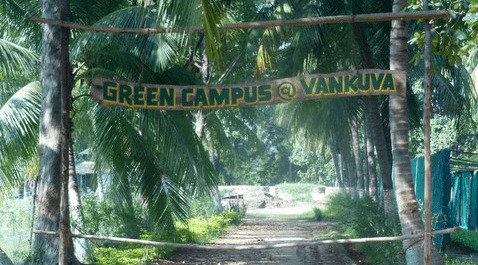While on sabbatical, my husband, daughter and I stepped into another world, a highly desirable future, ironically located in Gujarat, India. “Ironically” because we seldom think of desirable global futures existing in India’s poverty, population, and extreme development challenges. However, the founder, deceased, and her successor management team at the Muni Seva Ashram have thought about what is important for human well being and built a community based on those values.
This is not a community united by a religion, but rather by a belief in four pillars of society: education, social cause, healthcare, and sustainable development. The web address is http://www.greenashram.org. The setting is lush Gujarati countryside—tropical greenery, colorful flowers, and aesthetic buildings designed for purpose and human comfort. There is even a river complete with crocodiles which inhibit any swimming or washing in its waters. Visually it is stunning. But that is not its power; nor is its serenity; its transformative power is in what it demonstrates for the world using its four pillars:
Sustainable Development: The ashram has approximately 1600 residents and almost all energy is provided by renewable sources, primarily innovative applications of solar energy; and this despite the fact that Gujarat is the only state in India with reliable electricity for all its citizens. The extensive farming is organic as is the care and feed for the buffalos providing milk for the ashram and surrounding villages. The agriculture will soon be without any plastic used on the ground or to protect fruit from birds; in fact the school is on its way to being completely plastic free within a year. The 500 children educated at the ashram are from villages and are being taught sustainable farming to take back to their villages; curriculum encourages the children to return to farming areas with professional skills to maximize productivity and sustainability, to build strong families, and to reduce the sad exodus to the cities. Of course many students go on to professional careers and higher education.
Healthcare: The ashram runs a multi-facility hospital/clinic and one of the leading cancer hospitals in the country. The cancer hospital serves the local village community and increasingly attracts patients from developed countries. The care is superb, patient focused, the equipment state-of-the-art, the staff well educated attracting Indian physicians from around the world. The ashram guesthouse provides comfortable housing (TV, internet and en suite bathrooms) for families of patients.
Social Cause: As the ashram management identified needs in the local community they built the necessary infrastructure: a lovely home for differently abled women; senior citizen retirement facilities carefully thought out to tend to the social (as well as physical) needs of the elderly; and an orphanage for girls. All managed with love and intelligence, an understanding of how to encourage the best in people, excellent facilities, a culture of security, and attention to changing needs at various stages in life.
Education: The ashram is home to a kindergarten, primary school, a residential secondary and higher school, a vocational training center and a new School of Nursing. The schools address the needs of tribal youth: standard Indian curriculum, modern computer lab, Hindi, English, rich science program and at its core environmental sustainability. The student created posters in the classroom were world-class in substance, originality, and understanding of the relationship of humans to the environment. There were beautiful Diwali sand paintings raising issues of women’s rights, population, gender inequity and male-preference.
Everyone who works at the ashram is paid. Teachers, nurses, doctors and cooks—it is a “real world” and not an escape from reality. However, in the final accounting, the economic model, which is largely dependent on non-resident Indians, is the remaining challenge in thinking through the ashram as a viable model for sustainable communities and global sustainability. While farming and services provide some income to the ashram, it is not yet financially self-sufficient. This in no way diminishes its importance or what we have to learn from it.
MAHB-UTS Blogs are a joint venture between the University of Technology Sydney and the Millennium Alliance for Humanity and the Biosphere. Questions should be directed to joan@mahbonline.org.
MAHB Blog: https://mahb.stanford.edu/blog/on-the-way-to-getting-it-right/
The views and opinions expressed through the MAHB Website are those of the contributing authors and do not necessarily reflect an official position of the MAHB. The MAHB aims to share a range of perspectives and welcomes the discussions that they prompt.
